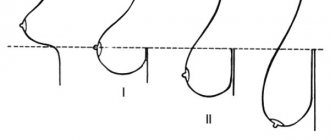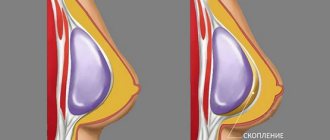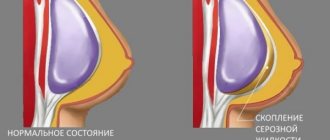When a woman begins to fight breast cancer, it seems that the main thing is to defeat the tumor, even at the cost of a mastectomy. However, already at this stage it is important to involve not only an oncologist in cancer treatment, but also a plastic surgeon - in order, if possible, to combine breast removal surgery with breast reconstruction. And if this is not possible, make a plan for future mammoplasty. If this is not done, events may not develop in the most successful way. Here is a case from practice told by Mikhail Vladimirovich Ovchinnikov, a plastic surgeon at the Correct Clinic, an oncologist surgeon, and a full member of international medical associations.
Photo after the first unsuccessful breast reconstruction
A 48-year-old patient consulted Dr. Ovchinnikov, who two years earlier had been diagnosed with cancer of the right breast. After four courses of preoperative chemotherapy, she underwent a subcutaneous mastectomy, at the same time the axillary lymph nodes were removed and a breast expander was installed. After surgery and examination of the tumor, the patient underwent several more courses of chemotherapy and radiation therapy to the armpit area, since several lymph nodes were affected by the tumor.
“It would seem that everything was done correctly,” says Mikhail Vladimirovich, “but the selected tissue expander turned out to be completely inappropriate for the size of a healthy breast. The obvious difference in height, width, and breast projection was due precisely to the incorrect selection of the expander. In addition, the fold under the breast (submammary fold) was completely destroyed and smoothed, and the pectoralis major muscle was cut off so high that it practically did not cover the expander in front. The overstretched expander caused thinning of the skin, creating a risk of possible skin necrosis.
The photo after the first breast reconstruction shows how asymmetrical the mammary glands are
It turned out that the regional hospital where the patient was treated simply did not have expanders of a different size, and everyone was fitted with what was available. After a complete preoperative examination (it was necessary to exclude recurrence of the disease and the presence of metastases in other parts of the body), 16 months after the first operation, the patient underwent a second breast reconstruction:
- replaced the round expander with an anatomically shaped implant of a suitable size;
- performed reconstruction of the inframammary fold so that the breast and fold were as natural and symmetrical as possible;
- covered the implant under the skin with a combined mesh so that there is no strong pressure on the skin and its necrosis does not occur;
- We enlarged the healthy breast with a slightly smaller anatomical silicone implant in order to also achieve maximum symmetry.
A month after the second breast reconstruction
, “Unfortunately, during this operation it was not possible to restore the nipple and areola,” regrets Mikhail Ovchinnikov. “The fact is that the nipple is formed, as a rule, from local integumentary tissue, and the coating over the implant was only 2-3 mm, and we would greatly risk the entire result if we began to restore the nipple as well. In my opinion, we have achieved an acceptable aesthetic result. The patient is no longer embarrassed to wear an open neckline.
Breast reconstruction after mastectomy: what's new
A mastectomy is a serious challenge for a woman, both physically and psychologically. However, the adjustments that a sudden illness makes are not a reason to despair, give up caring about your appearance, avoid your own reflection in the mirror and radically change your lifestyle. Breast removal after oncology is one of the main indications for breast reconstruction surgery.
Six months after the second breast reconstruction
Today, restoration of the mammary glands is carried out at a high level, and subject to careful oncological treatment, the patient is not at risk of relapse of the disease. Doctors come to the aid of the most advanced materials and instruments, which have just been tested in the most reputable clinics of the Old World and have already appeared in Russia. This list includes:
- tissue expanders;
- silicone implants of the latest, sixth generation with cohesive gel or polyurethane;
- combined titanized meshes, allowing to completely preserve the pectoralis major muscle and its function, without leading to disability;
- super-tech flaps made of ADM (acellular dermal matrix) biomaterial, which turns into its own tissue after a few weeks;
- reconstruction by microsurgical transplantation of own tissue from the abdomen, back or buttock region;
- the latest fluorescent imaging device, which helps assess the safety of such transplantation directly during surgery.
These developments in modern oncology mammology make it possible to achieve impressive results: a woman becomes the owner of a beautiful bust, quickly returns to the usual rhythm of life and ceases to be ashamed of her own body. Thanks to the latest techniques in the field of plastic surgery, the overall treatment strategy strives to reduce the volume of surgical intervention, minimize the risk of complications and injury, and provide the most comfortable conditions during the rehabilitation period.
Contraindications to reconstructive plastic surgery
A plastic surgeon or oncologist may refuse to perform an operation if the patient has a number of contraindications:
- unfinished cycle of cancer treatment, for example, radiotherapy;
- progression or relapse of the disease;
- presence of metastases.
How can you restore lost breasts?
Breast reconstruction can be performed using the following methods:
- Using silicone implants
- Using your own fabrics
- Combination of own tissues and silicone implants
There is no “best” way of breast reconstruction. The method is selected together with the surgeon, taking into account the size of the mammary gland, the disease, the treatment performed or planned, as well as the constitution, general health and the presence of bad habits.
Your surgeon should explain to you the pros and cons of each method as it applies to your situation and give you his or her opinion regarding the choice of reconstruction method.
Currently, the incidence of complications of reconstructive interventions has been reduced to a minimum, but this is true for patients in whom the correct choice of reconstruction technique was made.
The risk of reconstruction complications may also be high in patients who are overweight, have chronic diseases such as diabetes, systemic connective tissue diseases, and cardiovascular diseases. A bad habit such as smoking can cause serious complications, so you should think about getting rid of it before reconstruction.
Most reconstructive techniques include several stages. The first stage, regardless of the method, always requires hospitalization and general anesthesia. The final stages, such as nipple and areola reconstruction or lipofilling, can be performed on an outpatient basis.
What you need to know about reconstructive mammoplasty
Breast reconstruction after mastectomy is an atypical plastic surgery that requires an appropriate planning approach. First of all, the plastic surgeon must be an oncologist in order to correctly and safely select the required type of reconstruction, without complicating the treatment of breast cancer. Otherwise, it is necessary to convene an in-person consultation between a plastic surgeon and an oncologist.
This “marking” is done before breast reconstruction surgery.
This point of view is shared by world experts. Depending on the current condition of the breast, whether after a complete radical mastectomy, unsuccessful reconstruction, breast resection (partial breast conservation) or with a tumor, a step-by-step individual plan for the operation is drawn up, possibly in several stages.
In this case, the doctor must take into account several factors: the current state of health, the type of mastectomy (with or without preservation of the skin and nipple-areolar complex), the proportions of the figure, the condition of postoperative scars, the amount of tissue remaining after the mastectomy, the need for radiation therapy, etc. The doctor and the patient needs to understand what result they want to achieve as a result of the operation, what stages need to be completed and what additional treatment may be required. Ideally, all details are discussed before the very first breast removal operation - this is why the oncologist and plastic surgeon must be “combined” in one person.
Photos before and after the second mammoplasty
Thus, simultaneously with reconstructive surgery, you can not only restore the natural shape, nipple and areola, but also increase the volume of a healthy breast, lift it or reduce it. All this is often necessary to achieve absolute symmetry. A plastic surgeon will help you choose implants based on size, shape, and trusted manufacturer. To facilitate the creation of an individual plan, step-by-step 3D modeling is performed on a computer.
Reconstructive mammoplasty is performed under general anesthesia. The doctor may prescribe a different range of preoperative examinations in accordance with the stage of the disease.
Repeated breast surgeries – simple and complex, expensive and economical
In all of the above cases, surgical correction can give an excellent result that will completely satisfy the patient.
Is revision breast surgery always a more complex procedure?
This is not always true. To correct the result of unsuccessful breast surgery, in some cases (for example, when correcting the position of an implant), it is enough to carry out a very small intervention, which will take only 20-30 minutes (performed on an outpatient basis, without hospitalization). But sometimes a rather complicated, sometimes even two-stage operation with removal and subsequent replacement of implants may be required.
Revision breast surgery is always more difficult, so does it cost more?
As a rule, this is true. However, sometimes the result of unsuccessful mammoplasty can be corrected with very little intervention. And in half of the cases, this can be done without replacing implants. Your revision mammoplasty may not be as complicated as it seems, and the cost will be even less than you expected. You can only find out about this during a consultation.
Is unsuccessful breast surgery a nightmare that cannot be corrected?
This is absolutely not true. Anything can be fixed. Sometimes it is not difficult at all, and sometimes it is not as easy as we would like. But usually everything is not as scary as it seems to the patient. Therefore, there is no need to panic and be nervous. The best strategy: do not torture yourself in vain, but seek advice from a good specialist as early as possible, evaluate all options and calmly make a decision.
There are cases when you cannot postpone making a decision for a single day and YOU MUST RUN TO THE DOCTOR IMMEDIATELY!
We are talking about cases of serious infection or implant rejection. Nowadays, such things are becoming less common, but they still remain the most potentially dangerous complications of mammoplasty. In these cases, you absolutely need to contact a plastic surgeon URGENTLY. To eliminate the source of infection, as a rule, removal of the implant and serious treatment of the inflammatory process is required. Re-installation of implants is possible only 3-6 months after complete healing.
The prognosis for repeated plastic surgery (in case of timely and correct treatment of the complication) is positive.
Rehabilitation after mammoplasty
Depending on the scope of reconstructive mammoplasty, a woman can stay in the clinic under the supervision of a doctor from 1 to 4 days. This is necessary to maintain the safety of the operated tissues, especially during microsurgical interventions. In the early stages of recovery after breast surgery, there is discomfort and slight swelling. Sutures in almost all cases are made with absorbable material and do not require removal.
In the next 4-6 weeks after mammoplasty, you should avoid sports and any physical activity, including heavy lifting, as well as hypothermia, overheating (hot baths, visiting a sauna, bathhouse or solarium) and prolonged exposure to the sun. During the rehabilitation period, doctors do not recommend sleeping on your stomach, smoking or abusing alcohol. Special underwear, ointments, regular dressings and monitoring of breast condition by a specialist are an integral part of recovery.
Scars and scars after a certain time and after using silicone patches become almost invisible. Sometimes it is not possible to fully restore breast sensitivity. The final result of breast reconstruction can be assessed after 3–4 months.
Rehabilitation using prostheses
The use of a prosthesis is a reversible option that does not require another surgical intervention. First of all, prostheses perform an aesthetic function and compensate for a cosmetic defect. They help a woman overcome the psychological trauma associated with the loss of a breast. Modern breast prostheses are lightweight, do not pull on the skin and will not cause an allergic reaction. It often happens that the patient is not recommended to have an implant installed immediately after a mastectomy. Repeated surgery is possible no earlier than after 6-8 months, during which time she can use a prosthesis made of fiber filler, which will not put stress on the surgical area.
How to avoid complications after breast reconstruction
Outdated methods of breast reconstruction remain a thing of the past, and the indications for it are becoming wider and the technical equipment is becoming better. Numerous studies show that the likelihood of breast cancer recurrence is influenced not by reconstruction, but by the type of tumor and the stage of the process. A history of cancer requires constant monitoring, so regular medical examinations should never be neglected.
When choosing a plastic surgeon and clinic, you should not be guided by the desire to save money. If you trust your health and beauty only to experienced, specialized, highly qualified specialists, strictly follow the doctor’s instructions and set yourself up to achieve a successful result, the risk of complications will be minimized.
How is revision mammoplasty performed?
There's nothing special here. For the patient, repeated breast surgery is not much different from the primary one. The operations are performed under general anesthesia and are completely comfortable. As already mentioned, they can be both very simple and quite complex, so the duration of each intervention can vary greatly (from 20-30 minutes to 2-3 hours). Revision breast surgeries can be performed with or without implant replacement. Each case is individual, so the patient can only learn about the details of her operation during a face-to-face consultation with a plastic surgeon.











